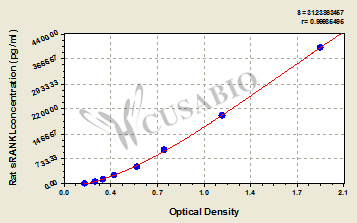| Code | CSB-E05126r |
| Size | 96T,5×96T,10×96T |
| Price | Request a Quote or Start an on-line Chat |
| Trial Size |
24T ELISA Kit Trial Size (Only USD$150/ kit) * The sample kit cost can be deducted from your subsequent orders of 96T full size kits of the same analyte at 1/5 per kit, until depleted in 6 months. Apply now |
| Intra-assay Precision (Precision within an assay): CV%<8% | ||||||
| Three samples of known concentration were tested twenty times on one plate to assess. | ||||||
| Inter-assay Precision (Precision between assays): CV%<10% | ||||||
| Three samples of known concentration were tested in twenty assays to assess. | ||||||
| To assess the linearity of the assay, samples were spiked with high concentrations of rat sRANKL in various matrices and diluted with the Sample Diluent to produce samples with values within the dynamic range of the assay. | ||||||
| Sample | Serum(n=4) | |||||
| 1:1 | Average % | 95 | ||||
| Range % | 89-101 | |||||
| 1:2 | Average % | 96 | ||||
| Range % | 91-105 | |||||
| 1:4 | Average % | 97 | ||||
| Range % | 93-102 | |||||
| 1:8 | Average % | 94 | ||||
| Range % | 90-99 | |||||
| The recovery of rat sRANKL spiked to levels throughout the range of the assay in various matrices was evaluated. Samples were diluted prior to assay as directed in the Sample Preparation section. | ||||||
| Sample Type | Average % Recovery | Range | ||||
| Serum (n=5) | 94 | 89-100 | ||||
| EDTA plasma (n=4) | 100 | 96-103 | ||||
| These standard curves are provided for demonstration only. A standard curve should be generated for each set of samples assayed. | |||||||||||||||||||||||||||||||||||||||||||||||||||||||||||||||

| |||||||||||||||||||||||||||||||||||||||||||||||||||||||||||||||
The Rat soluble receptor activator of nuclear factor-kB ligand (sRANKL) ELISA Kit is a powerful tool for quantitative analysis of the Receptor activator of nuclear factor-kB ligand (Tumor necrosis factor ligand superfamily member 11 protein) in rat samples.
This ELISA kit is specifically designed for the measurement of sRANKL protein levels in a variety of sample types, including serum, plasma, and cell culture supernates from Rattus norvegicus (Rat) species. With a detection range of 62.5 pg/mL to 4000 pg/mL and a sensitivity of 15.6 pg/mL, this ELISA kit can accurately detect even low levels of sRANKL protein.
The assay principle is based on a sandwich immunoassay, which involves the use of two specific antibodies that bind to different epitopes of the target protein. This approach ensures high specificity and sensitivity in the measurement of sRANKL levels. The assay can be completed in just 1-5 hours, with a sample volume of 50-100ul, making it a fast and convenient option for research. This ELISA kit has been cited in over 14 research articles, demonstrating its reliability and accuracy.
There are currently no reviews for this product.